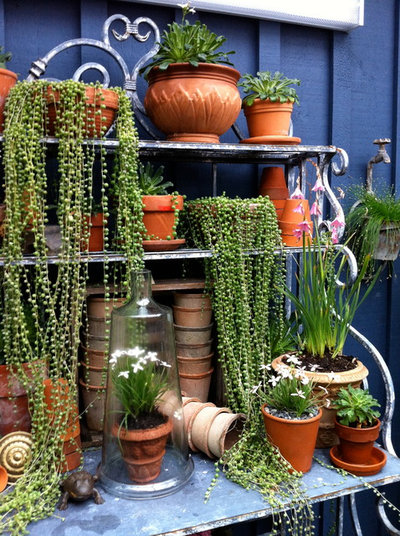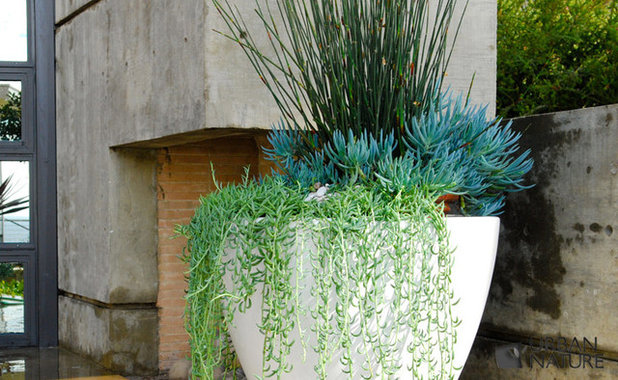String of Pearls and String of Bananas are cascading succulents in the
Senecio genus that provide whimsy and interest with minimal care. They work great as a delicate hanging plant or as a "spiller" that adds textural interest to mixed planters. Like most succulents, they're simple to propagate, which means that even the most novice houseplant enthusiast can have containers literally dripping with String of Pearls or Bananas.

Glenna Partridge Garden Design
String of PearlsThe plant commonly called String of Pearls truthfully looks more like a string of peas. It has small spherical leaves about ¼ inch in diameter, "strung" on thin stems like beads, resulting in a truly unique specimen.
String of Pearls prefers two to three hours of direct sunlight per day as a houseplant, though it can grow indoors under strong artificial light for 14 to 16 hours daily in the growing season, and 12 hours a day in the winter.
Want to enjoy your String of Pearls outdoors during warm months? No problem. It can take the heat, but keep it shaded from any intense midday sun.

Going Home To Roost
Despite its delicate appearance, this unusual succulent is a vigorous grower. Its trailing stems can reach 2 to 3 feet in length.
With good care a String of Pearls houseplant will live several years, though it may become straggly over time, so it's a good idea to continually trim longs strands and use the cuttings to propagate the plant within the same pot or in a separate one.
Propagation: Take 4-inch stem-tip cuttings, preferably in the spring or summer, and insert them into a moist potting medium. Press them into the potting mix until the leaves are almost covered. Keep the medium lightly moist. The cuttings will root quickly from where the leaves are attached to the stem.

Linda Fritschy Interior Design
String of Pearls has tiny blooms that some find attractive; others
aren't exactly sold — the blooms can look somewhat weed-like.
Make it bloom: Give your String of Pearls plant a cool rest (55 to 60 degrees Fahrenheit; 13 to 16 degrees Celsius) and reduce watering in the winter, though don't allow the potting mix to dry out completely. With some luck these cool, dry conditions may promote blooming in spring with clusters of small, white trumpet-shaped flowers.

Urban Nature / Troy Silva Design Group
String of BananasThe second trailing succulent species of interest is called String of Bananas (
Senecio radicans); it is native to the Cape Province area of South Africa. As a succulent, its tissues conserve moisture, rendering it well adapted to dry, hot conditions, though it also grows well in tropical conditions, too. Like most succulents, this species is frost tender and cannot withstand freezing temperatures (below 32 degrees Fahrenheit), though of course it can be a great houseplant in colder regions.

Going Home To Roost
Like its cousin, String of Bananas grows quickly and propagates easily. It produces small, cinnamon-scented, white or off-white flowers, usually in the late winter or early spring, though like most of the plants in the
Senecio genus, it is appreciated more for the color, shape and texture of its foliage than for its blooms.

Justina Blakeney
How to care for String of Pearls and String of Bananas:Care for these two succulents is essentially the same, though String of Bananas may be slightly more tolerant of high and low outdoor temperatures.
Temperature: Warm spring through fall (70 to 80 degrees Fahrenheit; 21 to 27 degrees Celsius). In winter, cool (55 to 60 degrees Fahrenheit; 13 to 16 degrees Celsius). Avoid drafty locations, air conditioners and open windows, because cold air may cause leaf drop.
Light: Bright light with some direct sun indoors; light shade outdoors. Place the plant in a bright, sunny window, preferably one facing west or south. If natural light is limited, place the plant 6 to 12 inches below a fluorescent light fixture for 12 to 16 hours per day.
Water: Water thoroughly until water drips through the drainage holes, usually no more than once per month. Discard water remaining in the drainage saucer and never allow the pot to stand in water. This plant will not tolerate soggy soil. Allow the potting mixture to dry out completely before watering the plant again. Provide water sparingly during winter. Give it just enough moisture to dampen the potting soil. Beads that look flat are a sign of underwatering.
Soil: Use cactus potting mix. If you want to mix your own, use 3 parts good quality potting soil to 1 part sharp sand.
Feeding: Not necessary, though you can fertilize every two to four weeks during spring and summer. Use a general-purpose liquid houseplant fertilizer, but dilute the mixture to one-third to one-half the solution recommended on the container. Withhold fertilizer during fall and winter.
Cautions: Considered toxic to humans and animals, so hang it out of reach of children and pets.





